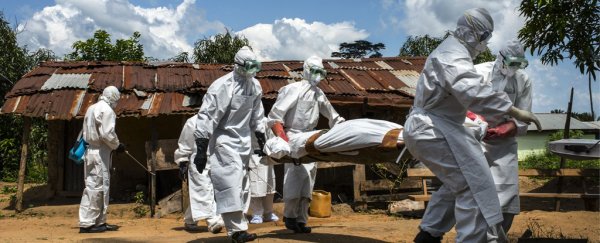More than four years after the Ebola epidemic in West Africa, scientists are still uncovering sobering new information about the lasting effects of the virus on survivors.
A study published Monday describes a Liberian woman, 33, who survived an Ebola infection during the 2014-2015 epidemic and then, one year later, apparently infected her husband and two of their sons.
One son, 15, died. The husband, 40, and other son, 8, recovered.
The study, in the Lancet Infectious Diseases journal, is the first indication of transmission from a female Ebola survivor, highlighting the continued risk for a resurgence of cases and the potential for large-scale outbreaks long after there is no longer active disease spread.
The epidemic in West Africa sickened more than 28,000 people, including more than 11,000 who died across Liberia, Guinea and Sierra Leone. A few cases have been reported of sexual transmission from the semen of male survivors; there has also been one report suggesting that the virus spread through a survivor's breast milk.
Researchers aren't sure how the woman in the Lancet study infected her husband and sons. They ruled out travel to areas where there was an active Ebola outbreak and contact with animals that could spread the virus.
The researchers said it was probably from close physical contact or contact with bodily fluids. (It is highly unlikely that the woman infected her husband through sex, researchers said. There is no recorded evidence of sexual transmission from female survivors.)
During the West African epidemic, family members in the same household became infected by cleaning a sick person's waste or washing linens or sharing utensils, said lead author Emily Kainne Dokubo, a medical officer and epidemiologist with the Centers for Disease Control and Prevention. Dokubo was deputy director of CDC's Ebola response in Liberia during the outbreak.
One of the biggest mysteries about Ebola, one of the world's deadliest pathogens, has been recurrent disease in survivors. Even after patients have fully recovered, virus particles have been detected in semen, breast milk, spinal fluid and the inside of the eye.
American physician Ian Crozier's left eye turned from blue to green because of the virus that remained in his body after he was infected treating patients in Sierra Leone in September 2014. A Scottish nurse recovered but had several relapses.
A study published in the Lancet two years ago warned that Ebola lingers in semen much longer than previously thought. One man was found to still carry the virus 565 days after he recovered from the illness.
The latest study "highlights the fact that we are just starting to understand the epidemiology and clinical course of Ebola virus infection," said Anne Rimoin, an infectious disease expert at UCLA and longtime researcher on Ebola who was not involved in the study.
"It also highlights the need for continued monitoring and study of Ebola virus survivors and their close contacts, long after an outbreak is declared 'over.' We still have a lot to learn about the nature of these persistent infections and what drives them."
Dokubo said: "We don't want countries to have a sense of complacency that everything is fine and we can go back to normal business. We need to keep in place the systems that can help prevent another outbreak from happening. "
Most survivors are healthy and have developed protective antibodies to reduce the chances of getting infected again, Dokubo said. Ebola reemergence is very rare, and researchers don't know what factors are associated with viral persistence, she said.
At the same time, she said, "we don't want to sound the alarm and have people thinking there are a bunch of people walking around with active virus."
The findings could "lead to additional stigma around survivors of Ebola," Lorenzo Subissi, an infectious disease expert in Brussels, noted in an accompanying commentary.
Vaccination, which was deployed to fight the recent Ebola outbreak in Congo, could become an important strategy to control both spread and stigma, he wrote.
A team of three dozen researchers from the CDC, the World Health Organization and Liberia's Ministry of Health, among others, investigated the woman's family and analyzed the genetics of the virus found among them.
In July 2014, the woman cared for her sick brother, who later died of Ebola.
She became very sick with symptoms consistent with Ebola infection. (Initial symptoms typically include tiredness, headache and fever. That is often followed by vomiting, diarrhea and, in some cases, bleeding.)
She recovered but was never diagnosed or treated; she was later found to have antibodies to the Ebola virus, indicating that she had been infected.
In May 2015, Liberia was declared Ebola-free. A flare-up of cases occurred afterward but was quickly contained. The country was again declared Ebola-free on 3 September 2015.
On 27 September 2015, the woman had a baby. She fell sick about a month later. The authors speculate that her infection re-emerged then, because pregnancy can cause latent infections to turn into symptomatic disease.
While she transferred protective antibodies against Ebola to her newborn son, the authors suggest that she transmitted the virus to the other family members during her flare-up.
Genetic analysis suggests that the virus carried by the father and the two infected sons was similar and a continuation of the West African disease outbreak.
2018 © The Washington Post
This article was originally published by The Washington Post.
